The AMD Zen and Ryzen 7 Review: A Deep Dive on 1800X, 1700X and 1700
by Ian Cutress on March 2, 2017 9:00 AM ESTBenchmarking Performance: CPU System Tests
Our first set of tests is our general system tests. These set of tests are meant to emulate more about what people usually do on a system, like opening large files or processing small stacks of data. This is a bit different to our office testing, which uses more industry standard benchmarks, and a few of the benchmarks here are relatively new and different.
PDF Opening
First up is a self-penned test using a monstrous PDF we once received in advance of attending an event. While the PDF was only a single page, it had so many high-quality layers embedded it was taking north of 15 seconds to open and to gain control on the mid-range notebook I was using at the time. This put it as a great candidate for our 'let's open an obnoxious PDF' test. Here we use Adobe Reader DC, and disable all the update functionality within. The benchmark sets the screen to 1080p, opens the PDF to in fit-to-screen mode, and measures the time from sending the command to open the PDF until it is fully displayed and the user can take control of the software again. The test is repeated ten times, and the average time taken. Results are in milliseconds.
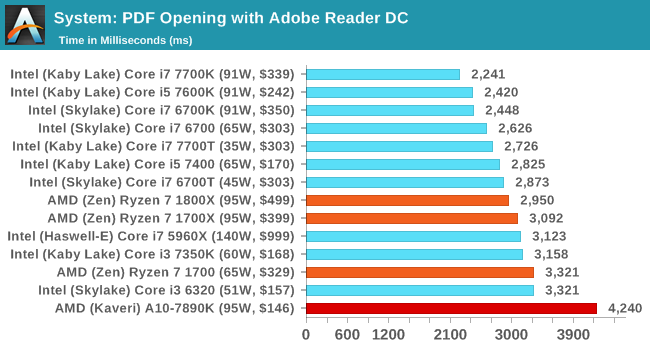
FCAT Processing
One of the more interesting workloads that has crossed our desks in recent quarters is FCAT - the tool we use to measure stuttering in gaming due to dropped or runt frames. The FCAT process requires enabling a color-based overlay onto a game, recording the gameplay, and then parsing the video file through the analysis software. The software is mostly single-threaded, however because the video is basically in a raw format, the file size is large and requires moving a lot of data around. For our test, we take a 90-second clip of the Rise of the Tomb Raider benchmark running on a GTX 980 Ti at 1440p, which comes in around 21 GB, and measure the time it takes to process through the visual analysis tool.
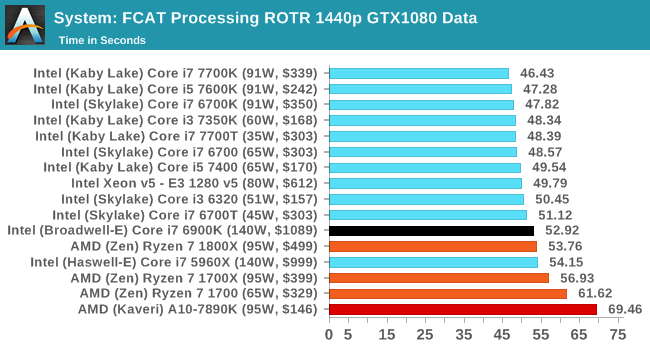
3D Particle Movement v2.1
This is the latest version of the self-penned 3DPM benchmark. The goal of 3DPM is to simulate semi-optimized scientific algorithms taken directly from my doctorate thesis. Version 2.1 improves over 2.0 by passing the main particle structs by reference rather than by value, and decreasing the amount of double->float->double recasts the compiler was adding in. It affords a ~25% speed-up over v2.0, which means new data.
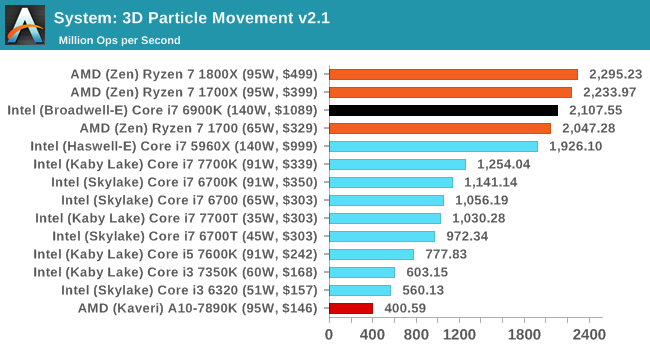
DigiCortex 1.16
Despite being a couple of years old, the DigiCortex software is a pet project for the visualization of neuron and synapse activity in the brain. The software comes with a variety of benchmark modes, and we take the small benchmark which runs a 32k neuron/1.8B synapse simulation. The results on the output are given as a fraction of whether the system can simulate in real-time, so anything above a value of one is suitable for real-time work. The benchmark offers a 'no firing synapse' mode, which in essence detects DRAM and bus speed, however we take the firing mode which adds CPU work with every firing.
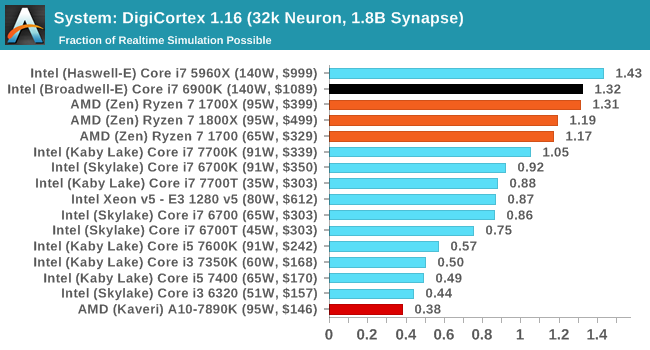
Agisoft Photoscan 1.0
Photoscan stays in our benchmark suite from the previous version, however now we are running on Windows 10 so features such as Speed Shift on the latest processors come into play. The concept of Photoscan is translating many 2D images into a 3D model - so the more detailed the images, and the more you have, the better the model. The algorithm has four stages, some single threaded and some multi-threaded, along with some cache/memory dependency in there as well. For some of the more variable threaded workload, features such as Speed Shift and XFR will be able to take advantage of CPU stalls or downtime, giving sizeable speedups on newer microarchitectures.

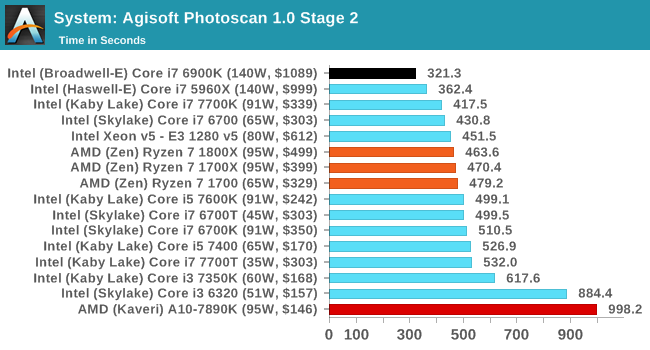
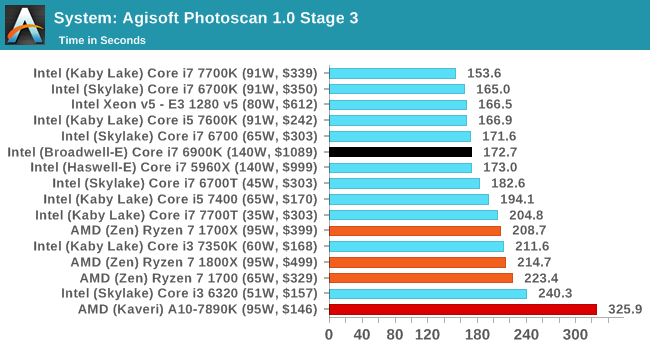
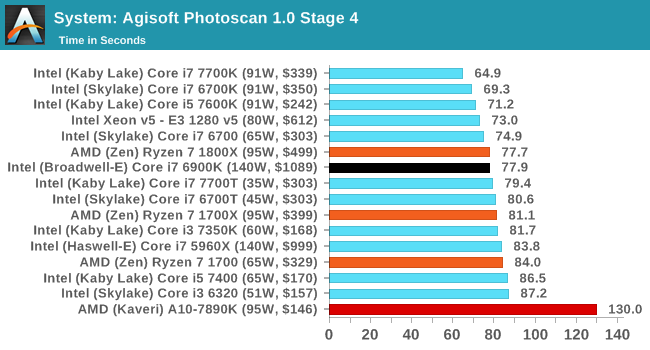
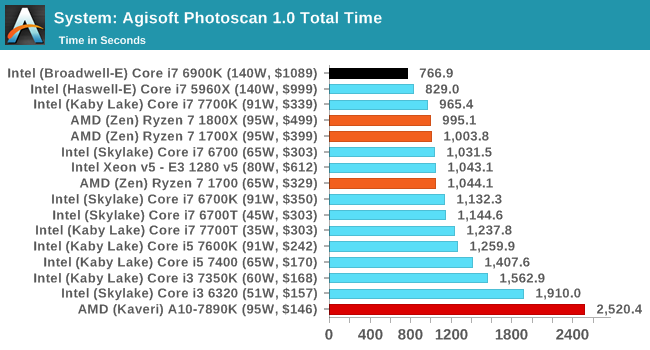










574 Comments
View All Comments
lakerssuperman - Thursday, March 2, 2017 - link
People like me. I was previously running a 2600k overclocked. Nice chip. Still runs great, but I was looking for an upgrade about a year ago as one of the things I do a lot of is Handbrake conversion for my HTPC. Going to even the newest Intel 4 core got me maybe 20% improvement on one of my major workloads for insane amounts of money and going to the high end to get 8-10 cores was just not justifiable.I ended up buying a used Xeon/X79 motherboard combo for around $300 off ebay. 8 cores/16 threads and it works great for Handbrake. I lost some clock speed in the move so single thread performance took a bit of a hit, but was more than made up for in multi-thread performance. I can still game on this CPU just fine and I don't play the newest stuff right away anyway just because of time constraints.
The X79 platform is fine for what I'm doing with it. Would I like the new stuff? Sure. And if I was in the position I was last year looking for an upgrade I don't see how I wouldn't get an 1800x. It gives me the right balance of features for what I do with my computer.
If I was just gaming, I'd look at Intel currently because their 4 core i5 is the sweet spot for this. But I'm not just gaming so this chip is infinitely more attractive to someone like me. With the price and features I can't see how it isn't a winner and when the 4 and 6 core parts come out at likely higher frequencies, I think they are going to be the real winners for gaming.
rarson - Thursday, March 2, 2017 - link
Ryzen is clearly well-suited to anyone who values high performance in a multitude of usage scenarios over one single usage scenario, especially if one cares about how much money they need to spend to achieve those results.injurer - Friday, March 3, 2017 - link
1800X is definitely designed for enthusiast, and AMD fans, but when you go to 1700X this is a price killer targeting the mainstream. 1700 is on the same boat but at even lower price. All the 3 are 8 core chips and are quite close to the 6900K but at 2-4 times lower price.At the end I really believe AMD are still having to show us the real potential of their architecture. Those chips are just the start. Remember Ryzen design is a new from its core, so they definitely have room to ecpand and enhance it.
bill.rookard - Thursday, March 2, 2017 - link
Well, thing to remember is that for those looking for a new build, they now have a legitimate choice. I still do see in the future that things will only go more multithreaded, and even though the i7-7700k is still a great chip, having more physical cores and resources to throw at it will only help.To that end, again, anyone planning a NEW build from the ground up will be able to seriously consider a Ryzen system.
Worst case, think about it. In the deep dive they had mention of 'competitive resource sharing' with SMT enabled. If you were to disable SMT on Ryzen - it would give you 8 PHYSICAL cores versus the 4 physical/4 logical cores of the 7700k. Without those resources being partially used across 16 threads - all resources would be allocated to the physical cores instead, potentially allowing more processing power per physical core.
There's still quite a bit to be checked out and dug through.
lilmoe - Thursday, March 2, 2017 - link
This. I want 2 things dug deeper in follow ups:1) Single/multi threaded performance with SMT disabled VS SMT enabled.
2) Game comparisons with more sensible GPUs (which actually ship and sell in volume, IE: the ones people actually buy), like the GTX 1060 and/or RX 480.
BurntMyBacon - Friday, March 3, 2017 - link
@lilmoeI agree with 1). Intel had HT for several generations before it was universally better to leave it enabled (still needs to be disabled some times, but these are more the edge cases now).
Not so sure I'm onboard with 2). Pairing a $200 GPU with a $500 processor for gaming purposes seems a little backwards. I'd like to see that (GTX1060 / RX480) gaming comparison on a higher clocked R5 or R3 processor when they are released.
Meteor2 - Friday, March 3, 2017 - link
I'd rather see tests paired with a 1080 Ti. At RX480/1060 level, it's well known the bottleneck is GPU performance not CPU. A 1080 Ti should be fast enough to show up the CPU.lilmoe - Friday, March 3, 2017 - link
@BurntMyBacon @Meteor2Lots of people, like me, are more into CPU power. I'm OK with a mid-range GPU. Gaming is not my top priority, and when I do, It's never above 1080p.
It'd be interesting to see if there are differences. I wouldn't dismiss it, saying the GPU would be the bottleneck so fast.
bigboxes - Sunday, March 5, 2017 - link
I'm with you on that. Gaming is way down in my priority list. I do it occasionally just because I love to see what my hardware can do. I currently have a ultrawide 1080p monitor. When I move to 4K then hopefully midrange GPU will cover that. My CPU is a 4790K. It's great for most tasks. I've been wanting to go to 6/8 core for some time, but the cost for the platform was too high. I think in a couple of years I will seriously think about Ryzen when building a new workstation.rarson - Thursday, March 2, 2017 - link
I am interested in seeing potential improvement due to BIOS updates. Additionally, I'm interested in seeing potential improvement due to better multi-threaded software. My hunch is that AMD is either on-par or better than Intel, or maybe damn near that prediction, so I think the 4-core parts will compare well to the current Skylake SKUs. I also expect them to overclock better than the 8-core chips. I guess we'll just have to wait for them to release.8 physical cores is definitely better than 4 cores with SMT/HTT/whatever you want to call it.